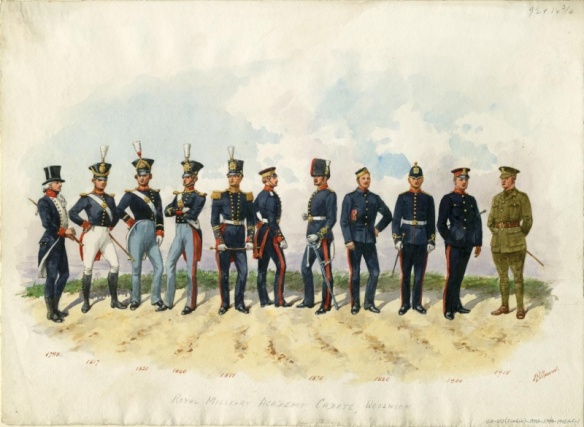Uniforms of the Royal Military Academy Woolwich 1799 – 1915.
The Royal Military Academy, Woolwich, was established in 1741, near the Royal Artillery Depot at Woolwich, with the objective, as stated in its first charter, of producing “good officers of Artillery and perfect Engineers” ( Royal Military Academy 2001, p. 1). The Corps of Royal Engineers, originally an all-officer corps, remained a component of the Royal Regiment of Artillery until 1787. Both remained under the control of the Board of Ordnance and were collectively referred to as the Ordnance Corps until reforms were enacted in 1856.
The Royal Engineers and Royal Artillery were also referred to as the “scientific corps” because of the technical nature of their duties and the requirement to complete an examination prior to entry at Woolwich, complete the formal program of instruction there, and pass another comprehensive exam prior to commissioning. These were stringent requirements, considering that up to 1849, at least 90 percent of the new commissions in the guards, cavalry, and infantry in the British Army at home were either given to, or purchased by, men who had not undergone any form al admission or educational tests.
About 100 cadets entered Woolwich annually. Each spent two to four years in theory classes before passing into a final practical course, although the length of the entire program of instruction fluctuated with the demand for new officers. Seven hours per day were devoted to studying.
An incentive to study at Woolwich was the fact that upon commissioning, the new officers were placed on an order of merit list. This was significant because at the time promotion in the Ordnance Corps was by seniority, not purchase. (The system of purchasing officer commissions was abolished in 1871.) Moreover, when there were more candidates than vacancies in the Royal Engineers – which at one time offered better pay and had more assignment opportunities than the Royal Artillery – only those higher on the order of merit list became Royal Engineers.
The minimum admission age at Woolwich was initially fourteen years, but between 1855 and 1858, it was increased to seventeen years. Stiffer entrance examinations were required at Woolwich, and candidates were examined in eight subjects (Classics, mathematics, English, French or another modern language, history with geography, natural sciences, experimental sciences, and drawing). Admission to Woolwich also became partially competitive. Between 1855 and 1858, about 60 percent of those entering Woolwich were either university educated or public school educated. By 1890, about 90 percent of Woolwich entrants were public school educated.
In 1936, it was decided to amalgamate Woolwich and the Royal Military College, Sandhurst, a process completed in 1947 with the opening of the Royal Military Academy, Sandhurst.
Woolwich was also called the Shop, since its first building was a converted work shop at the Woolwich Arsenal.
